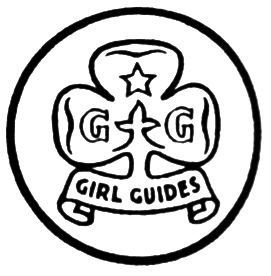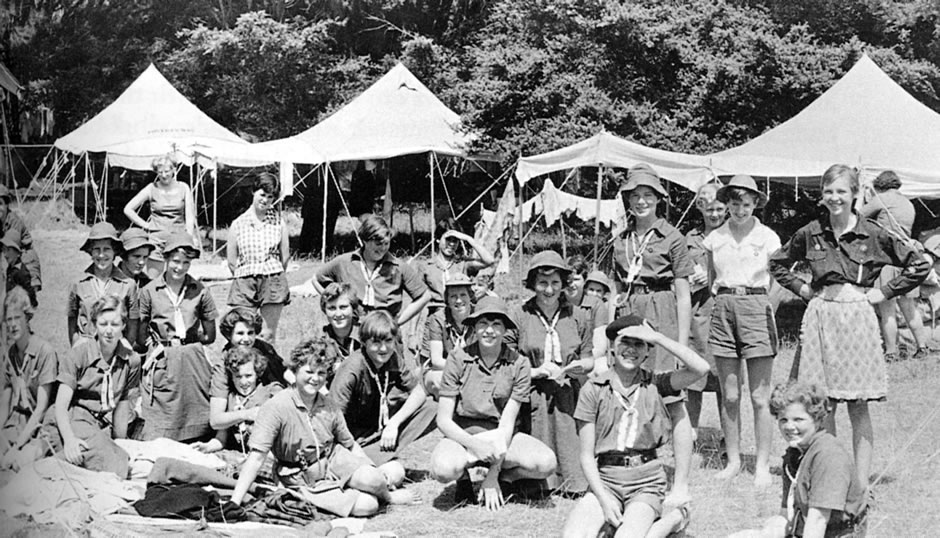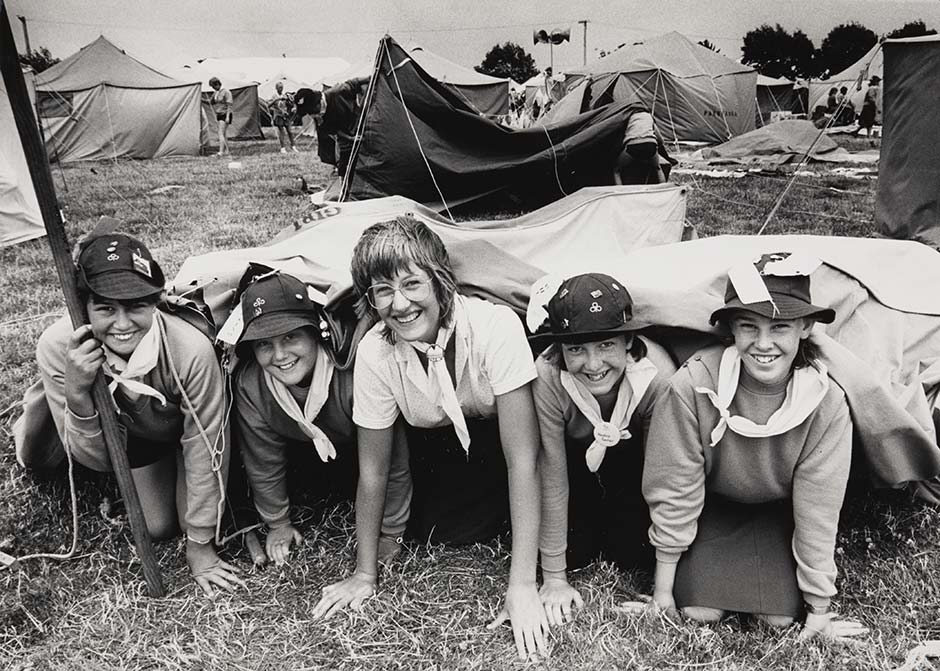
GirlGuiding New Zealand
1908 –
Theme: Sport and recreation
Known as:
- Girl Peace Scouts' Association
1908 – 1923 - Girl Guides Association New Zealand
1923 – 2008 - GirlGuiding New Zealand
2008 –
This essay written by Judith Bright was first published in Women Together: a History of Women's Organisations in New Zealand in 1993. It was updated by Judith Bright in 2018.
1908–1993
The Girl Guides Association New Zealand (GGANZ) was formed as a uniformed voluntary youth organisation for girls and young women aged 6–19; its mission, as stated in 1993, was 'to help girls develop into confident and self-respecting young women, responsive to the needs of others'. [1] In 1992 there were over 32,000 uniformed members. [2]
In 1909, when the recently formed Boy Scouts paraded in front of their founder, General (later Lord) Robert Baden-Powell, at Crystal Palace in London, a group of uninvited girls were among them, attempting to break free of Edwardian restrictions on suitable activities for young ladies. Baden-Powell responded by asking his sister Agnes to organise the Girl Guide movement, which was formed the following year.
In New Zealand the first Boy Scout patrols were set up by Lt Col. David Cossgrove of Rangiora in 1908. The local patrol, however, refused to allow his daughter Muriel and her friends to join, because the activities were not considered ladylike; so in September that year they formed a troop of Girl Peace Scouts, based on Baden-Powell's Scouting for Boys.
In 1910 Cossgrove published Peace Scouting for Girls, with chapters on camping, self-defence and watermanship; his wife contributed chapters on home nursing, child management and invalid cookery. In his introduction, Cossgrove described Peace Scouting as 'a scheme for the moral, physical and intellectual training of girls and young women, as well as for their instruction in good citizenship'. [3] By 1911 some 1500 girls had been enrolled in patrols throughout the country.
Eventually a few Girl Guide companies were started in New Zealand by women who had been involved in Guiding in England; the first known was at Ngā Tawa School in 1919. The two movements sat somewhat uneasily alongside each other until October 1923, when the Peace Scouts registered with the World Association as the New Zealand Girl Guides Association, with Lucinda Wilson as the first chief commissioner and Lady Jellicoe as the first Dominion president.
Fairy Peace Scouts, started in 1918 for girls aged 7–10, became Brownies, and Ranger Guides were introduced for girls aged 14–19. The movement expanded, and by 1930 6500 girls were enrolled. In 1926 Guiding by Post began for girls unable to join active units. This later split into the Post branch for those with disabilities and the Lone branch for those in remote areas. By 1993 girls with special needs were integrated into ordinary units, although the Lone scheme was still operating.

New Zealand Herald.
Second Dominion Girl Guides camp, held at Porea, near Marton, in 1957. More than 1000 girls from all over New Zealand attended.
Service to the community was always a major focus, and World War II provided many opportunities; these included knotting 3000 camouflage nets, gathering rosehips, and fundraising for an air ambulance. Some of New Zealand's experienced Guide leaders were among the Guide International Service teams who worked in Germany and Malaya. One was Mona Burgin, the first New Zealand leader to gain a Training Diploma, and a former Peace Scout leader, who was later to become well known for leadership of both Guides and Rangers in Auckland, and training leaders throughout New Zealand.
The post-war years brought an influx of girls to Guiding, and a gradual move to more indigenous programmes. British handbooks had been supplemented by local publications from about 1944, and in 1970 New Zealand leaders rewrote the programme to take account of local needs and interests. From that time, programmes for all ages were updated every ten years to keep them relevant; in 1990, for example, a computer badge was introduced. Uniforms were also updated in 1970 and 1980, and in 1985 there was a move away from the traditional blue to a smart aqua and navy mix-and-match outfit. This willingness to reassess and adapt its programmes and public image helped to ensure Guiding's survival.
The quality of leadership was also a significant factor in the movement's success. Training was provided at 'Ārahina', the National Training Centre in Marton, and at local level. The association believed 'that the needs of girls and young women are best met through an organisation catering specifically for girls and led by women'. [4] However, in 1992 it made provision for men to undertake some leadership roles, in recognition of their existing help, especially with camps, and as part of Guiding's emphasis on family involvement.
By 1993 the Christchurch-based National Council was responsible for the overall administration of Guiding in New Zealand, the Cook Islands and Western Samoa. Each of GGANZ's 21 provinces had its own commissioner, and was further subdivided into divisions and districts. Each district was administered by a support committee, responsible for about 6–8 'units' – Guide companies, Brownie packs and so on.
New Zealand's foundation membership of the World Association of Girl Guides and Girl Scouts provided many opportunities for local Guiders to attend international jamborees and gain an understanding of other cultures. GGANZ was also a member of the Federation of New Zealand Youth Organisations, the National Council of Women (NCW), the Scout Association of New Zealand, and the Salvation Army Territorial Youth Department. A Red Shield section of Guiding was formed in 1958 in partnership with the Salvation Army.

Alexander Turnbull Library, Dominion Post Collection, PAColl-7327-1-036-0142.
The Girl Guide Jamboree in Levin in 1988, after a storm.
The movement's growth was generally steady, with some fluctuations caused by changing birth rates and a shortage of leaders as more women entered paid employment. Membership peaked in the 1970s with 39,000 uniformed members, including 3600 adult leaders. The 1980s saw the first-ever decline in membership, possibly because of the increase in other leisure activities available and in outdoor and camping programmes in schools. GGANZ responded positively, for example by introducing Pippins for six-year-olds in 1983. By the 1990s membership was once again increasing.
Guide units continued to be organised on Baden-Powell's patrol system – a method of delegating authority and sharing responsibility. Girls were divided into small groups of usually four to six, with one chosen as leader. This provided a training ground for leadership, and enabled girls to participate in planning and carrying out activities at all levels.
The programme at weekly meetings covered a wide range of activities, from outdoor cooking and instruction in first aid and bushcraft, to drama, singing and games. The system of badges and awards encouraged girls to gain new skills and experiences. Brownies and Guides could work towards their three progression badges ('Ferns') and for a variety of interest badges; Guides worked on their eight challenge badges, [5] each of which had three levels, and then for their Chief Commissioner's Award; Rangers aimed for the Queen's Guide Award and the three levels of the Duke of Edinburgh award scheme. Girls also did a variety of community work, such as beach clean-ups, visiting old people, providing goods for refugees, and assisting local service organisations in their projects.
Although born in Edwardian times, Guiding still appealed to girls of the 1990s. The more traditional activities of camping, first aid, handcrafts and home skills went hand in hand with bush survival, civil defence training, conservation, boating skills, abseiling and mechanics. The emphasis continued to be on the girl's personal best, her relationship to others and, above all, on the fun and friendship Guiding offers.
Judith Bright
1994–2018
Over the 25 years of Girl Guiding in New Zealand from 1993, revisions of name, mission statement, programmes and focus redefined delivery for new generations without losing the core values and activities. The 2008 centenary name change to GirlGuiding New Zealand also brought a refreshed branding and uniform.
Te Ropu Tamariki, an after-school club for girls and boys, delivering life skills in lower socio-economic areas, took programme content into a wider arena without being badged as Girl Guides. Initially run by existing volunteer leaders, and later by paid staff, it offered a different way of delivery, until the programme folded due to a lack of available funding. This theme would be picked up again in 2016 with one-off activities focused to non-members. [6]
A revised leader development programme introduced in 2007 opened the possibility of NZQA accreditation, and set expectations for required standards and modular delivery. Although accreditation was not implemented, modular delivery of leader training continued. In 2000, the decision was made to sell Ārahina, the National Training venue in Marton which had been significant in the leadership development of so many members for 54 years, in acknowledgement of it being no longer accessible to leaders and girls. By 2018 the basic Leader Qualification training was offered mostly online to meet the needs of increasingly busy volunteers.
National jamborees continued to attract Guides and Rangers, with events held every four years in a variety of locations, and included tramps, sailing, drama, city experiences and other adventurous options. The Promise and Law (the key values statements), programme content and age groupings were reviewed from time to time, with modifications where needed in keeping with societal changes, with a definite focus towards girls being advocates for change in society. [7] A new programme for the post-ranger age group, Connect, started in 2015, with a focus of keeping former rangers in touch with the organisation, available to assist occasionally, and an awards scheme for personal development. [8]
On the international Guiding scene, New Zealanders continued to make an impact. Ginny Radford, a New Zealand leader, was elected as chair of the Board of the World Association of Girl Guides and Girl Scouts in 1999, and others were elected to the World Board and subcommittees at various times. [9]
A focus on young leaders with potential as the future of the organisation saw an intentional seeking of opportunities at international events such as the United Nations Commission on the Status of Women. International Guiding events were focussed towards advocacy in stopping violence, developing body confidence, and environmental issues. These programme foci were incorporated in the New Zealand Guiding programme, ensuring that girls’ voices were heard.
In 2016 further emphasis was put on girl leadership, with a Ranger Advocacy panel bringing the girls’ voice forward as a key element in the advocacy initiatives, such as consent education in schools, and the Guiding and Participation panel offering a youth opinion in national decision making. Programme focus broadened to include science, technology, engineering and maths (STEM) topics, as well as the traditional focus on outdoors and self-directed small group activities.
An annual external research survey, sent to a wide audience of non-Guiding as well as Guiding girls, identified the most important issues for girls each year. These themes then underpinned any new programme developments as well as advocacy campaigns.
New badges introduced at all programme levels took girls well beyond what was traditionally expected. Across all age groups, Girls Lead badges focused on girls taking responsibility for leadership within their units. In 2018, for example, Pippins could do ‘Discover’, based on STEM activities, and ‘Design and Build’. Similar themes ran through Brownie and Guide programmes. Brownies, Guides and Rangers focused on healthy body image through ‘Free Being Me’, and took this into advocacy in ‘Action on Body Confidence’. The Ranger programme included several advocacy certificates. [10]
The membership heights of the 1970s were not regained. As with other youth organisations and activities, the impact of a wide range of new options for leisure time, and a trend towards shorter periods of involvement as a range of activities were tried out, impacted on Guiding. Shorter term involvement in community pop-up events and development of online programmes were offering new opportunities, in order to ensure that the adventure and excitement first offered in 2008 continued.
Judith Bright
Notes
[1] Mission Statement, Te Rama, Vol. 6, November/ December 1991, p. 18.
[2] This total comprised 3179 Pippins (in 288 groups), 15,082 Brownies (820 packs), 9038 Guides (582 companies), 1044 Rangers (142 units), 295 junior leaders and 4169 adult leaders.
[3] Cossgrove, 1910, Introduction.
[4] Guide to Guiding, 1992, p. 14.
[5] The eight challenge badges in 1993 were Faith, Outdoors, Fitness, Heritage, Leisure, Lifeskills, Service and Technology.
[6] Ambitious Fun, 2008, p.206.
[7] The revised promise approved in 2014 was: ‘I promise to do my best, To be true to myself and develop my beliefs, To live by the Guide Law, And take action for a better world.’ See www.girlguidingnz.org.nz
[8] See www.girlguidingnz.org.nz
[9] Ambitious Fun, 2008, p.199.
[10] GirlGuiding NZ programme books, published 2015–2018.
Unpublished sources
GGANZ records, 1910–1985, ATL
GGANZ annual census papers, 1992, GGANZ National Headquarters,Christchurch
Mansell, Rick and Ann Hindson, 'Girl Guides Association Social Audit', GGANZ, 1989
Published sources
A Guide to Guiding in New Zealand, GGANZ,Christchurch, 1992
Baden-Powell, Robert S., Scouting for Boys, C. Arthur Pearson,London, 1908
Cossgrove, David, Peace Scouting for Girls, Office of the Dominion Scout,Christchurch, 1910
Dawber, Carol, Ambitious Fun: The Journey of Girl Guiding in New Zealand, Christchurch, GirlGuiding New Zealand, 2008
Dominion Guide, 1924–1931; New Zealand Guider, 1931–1936; Te Rama, 1936–1992. (Succeeded by emailed news sheets, website items and Facebook page items.)
Iles, Marie, 65 Years of Guiding 1908–1973, GGANZ, Christchurch, 1976

Community contributions